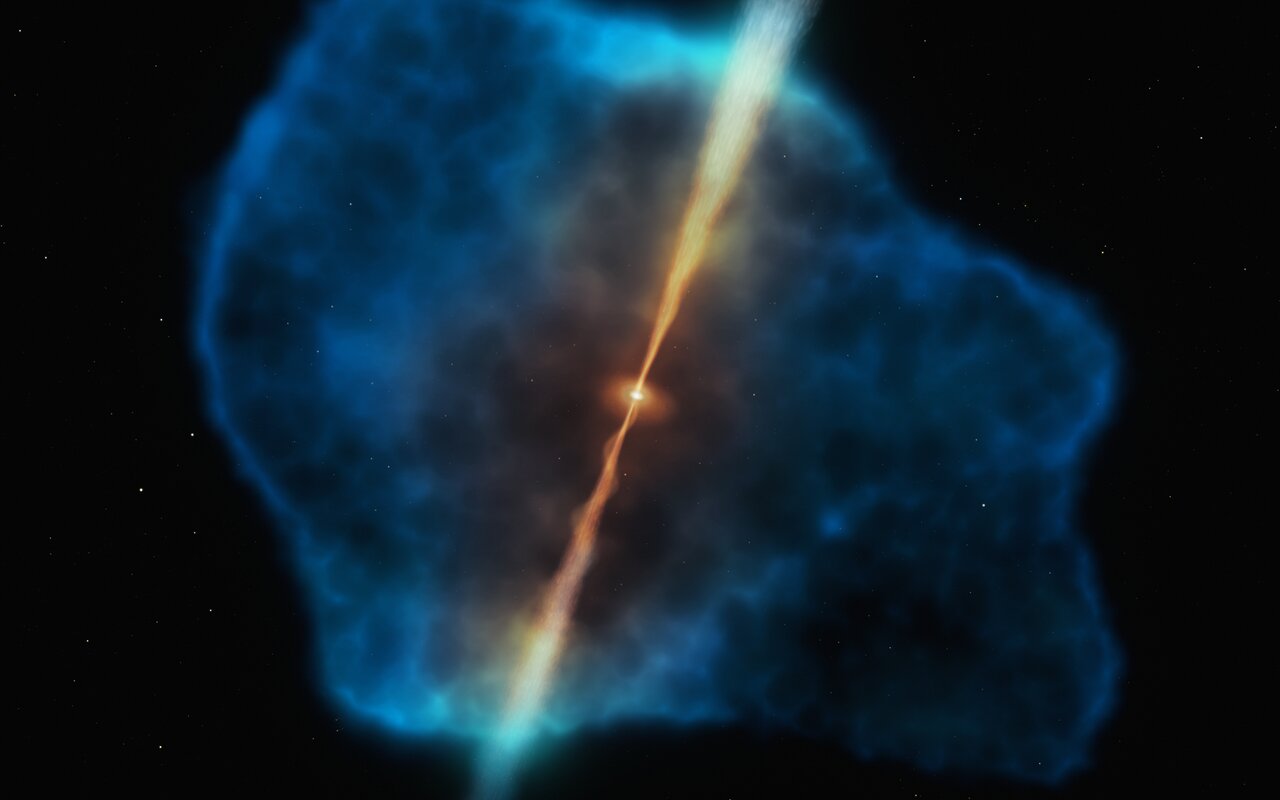Thanks to the vastly improved capabilities of today’s telescopes, astronomers have been probing deeper into the cosmos and further back in time. In so doing, they have been able to address some long-standing mysteries about how the Universe evolved since the Big Bang. One of these mysteries is how supermassive black holes (SMBHs), which play a crucial role in the evolution of galaxies, formed during the early Universe.
Using the ESO’s Very Large Telescope (VLT) in Chile, an international team of astronomers observed galaxies as they appeared about 1.5 billion years after the Big Bang (ca. 12.5 billion years ago). Surprisingly, they observed large reservoirs of cool hydrogen gas that could have provided a sufficient “food source” for SMBHs. These results could explain how SMBHs grew so fast during the period known as the Cosmic Dawn.
The team was led by Dr. Emanuele Paolo Farina of the Max Planck Institute for Astronomy (MPIA) and the Max Planck Institute for Astrophysics (MPA). He was joined by researchers from both the MPIA and MPA, the European Southern Observatory (ESO), UC Santa Barbara, the Arcetri Astrophysical Observatory, the Astrophysics and Space Science Observatory of Bologna, and the Max Planck Institute for Extraterrestrial Physics (MPEP).
For decades, astronomers have been studying SMBHs, which exist at the core of most galaxies and are identified by their Active Galatic Nuclei (AGN). These nuclei, which are also known as quasars, can emit more energy and light than the rest of the stars in the galaxy combined. To date, the most distant one observed is ULAS J1342+0928, which is located 13.1 billion light-years away.
Given that the first stars are estimated to have formed just 100,000 years after the Big Bang (ca. 13.8 billion years ago), this means that SMBHs had to have formed quickly from the first stars to die. Until now, though, astronomers had not found dust and gas in high enough quantities during the early Universe to explain this rapid growth.
In addition, previous observations conducted with the Atacama Large Millimeter/submillimeter Array (ALMA) revealed that early galaxies contained a lot of dust and gas, which fueled rapid star formation. These findings indicated that there would not have been much material left over to feed black holes, which only deepened the mystery of how they too grew so rapidly.
To address this, Farina and his colleagues relied on data gathered by the VLT’s Multi Unit Spectroscopic Explorer (MUSE) instrument to survey 31 quasars at a distance of around 12.5 billion light-years (thus observing what they looked like 12.5 billion years ago). This makes their survey one of the largest samples of quasars from this early period of the Universe. What they found were 12 extended and surprisingly dense hydrogen clouds.
These hydrogen clouds were identified by their characteristic glow in UV light. Given the distance and the effect of redshift (where the wavelength of light is stretched due to cosmic expansion), earthbound telescopes perceive the glow as red light. As Farina explained in an MPIA press release:
“The most likely explanation for the shining gas is the mechanism of fluorescence. The hydrogen converts the energy-rich radiation of the quasar into light with a specific wavelength, which is noticeable by a glimmer.”
The clouds of cool, dense hydrogen – which were several billion times the mass of the Sun – formed halos around the early galaxies that extended for 100,000 light-years from the central black holes. Ordinarily, detecting such clouds around quasars (which are intensely bright) is rather difficult. But thanks to the sensitivity of the MUSE instrument – which Farina described as “a game changer” – the team found them rather quickly.
As Alyssa Drake, a researcher with the MPIA who also contributed to the study, said:
“With the current studies, we are only just beginning to investigate how the first supermassive black holes were able to develop so rapidly. But new instruments like MUSE and the future James Webb Space Telescope are helping us to solve these exciting puzzles.”
The team found that these gas halos were tightly bound to the galaxies, providing the perfect “food source” to sustain both rapid star formation and the growth of supermassive black holes. These observations effectively resolve the mystery of how supermassive black holes could exist so early in the history of the Universe. As Farina summarizes it:
“We are now able to demonstrate, for the first time, that primordial galaxies do have enough food in their environments to sustain both the growth of supermassive black holes and vigorous star formation. This adds a fundamental piece to the puzzle that astronomers are building to picture how cosmic structures formed more than 12 billion years ago.”
In the future, astronomers will have even more sophisticated instruments with which to study galaxies and SMBHs in the early Universe, which should reveal even more details about ancient gas clouds. This includes the ESO’s Extremely Large Telescope (ELT), as well as space-based telescopes like the James Webb Space Telescope (JWST).
The study that describes the team’s findings appeared in the December 20th issue of The Astrophysical Journal.
Further Reading: ESO, MPIA, The Astrophysical Journal

